Experience of application of the water-based drilling fluid conservation technology in the wells drilling process at the perm region fields
UDC: 622.244.4
DOI: 10.33285/0207-2351-2023-10(658)-5-11
Authors:
NEKRASOVA I.L. 1
1,
KHVOSHCHIN P.A. 1
1,
GARSHINA O.V. 1
1,
PREDEIN A.A. 1
1,
KAZAKOV D.A. 1
1,
SHLAPATSKIY M.V. 1
1
1 LUKOIL-Engineering Limited PermNIPIneft Branch Office in Perm, Perm, Russia
Keywords: drilling fluid, conservation technology, bactericide, rheological parameters, filtration rate, drilling fluid cleaning system, microbiological destruction, block of additional containers
Annotation:
One of the drilling waste types is used drilling fluids, the volume of which can reach several hundred cubic meters per well. Repeated use of drilling fluids for drilling several intervals or wells is one of the main ways to reduce the volume of his type of waste and reduce the cost of well drilling. The article shows the results of experimental studies of a complex of bactericides and the procedure for conservation technology using in field conditions. The requirements for the mud cleaning system for the possibility of mud reuse are given. The results of pilot field tests of biopolymer drilling mud conservation technology during the directional wells drilling at one of the Perm Region fields are presented. The volume of used drilling mud has been reduced by 23 %, drilling waste by 31 % due to the use of conservation technology, compared with the basic technology. The most promising application of conservation technology is for expensive highly inhibited water-based drilling fluids in the conditions of multiple and conveyor drilling.
Bibliography:
1. Kompleks tekhnologicheskikh resheniy po sokrashcheniyu ob’emov obrazovaniya otkhodov bureniya / I.L. Nekrasova, P.A. Khvoshchin, D.A. Kazakov, O.V. Garshina // Stroitel’stvo neftyanykh i gazovykh skvazhin na sushe i na more. – 2022. – № 4(352). – S. 55–62. – DOI: 10.33285/0130-3872-2022-4(352)-55-62
2. Issledovanie glin i novye retseptury glinistykh rastvorov / V.D. Gorodnov, V.N. Teslenko, I.M. Timokhin [i dr.]. – M.: Nedra, 1975. – 272 s.
3. Asepticheskaya biodestruktsiya polisakharidnykh reagentov, primenyaemykh pri burenii skvazhin / B.A. Andreson, R.K. Andreson, E.A. Gil’vanova, N.G. Usanov // Neft. khoz-vo. – 2004. – № 6. – S. 64–67.
4. Belenko E.V. Izuchenie biodestruktsionnykh protsessov polisakharidnykh reagentov // Zashchita okruzhayushchey sredy v neftegazovom komplekse. – 2007. – № 8. – S. 32–36.
5. Minibaev V.V., Il’in I.A., Pesterev S.V. Metodika otsenki effektivnosti bakteritsidnykh reagentov dlya burovykh rastvorov // Stroitel’stvo neftyanykh i gazovykh skvazhin na sushe i na more. – 2010. – № 11. – S. 26–29.
6. Utilizatsiya burovykh rastvorov na vodnoy osnove / I.L. Nekrasova, P.A. Khvoshchin, D.A. Kazakov, O.V. Garshina // Zashchita okruzhayushchey sredy v neftegazovom komplekse. – 2022. – № 4(307). – S. 5–13. – DOI: 10.33285/2411-7013-2022-4(307)-5-13
7. Pat. 2786182 Ros. Federatsiya, C 09K 8/03. Sposob obrabotki burovykh rastvorov dlya povysheniya ikh mikrobiologicheskoy ustoychivosti / I.L. Nekrasova, P.A. Khvoshchin, D.A. Kazakov [i dr.]; zayavitel’ i patentoobladatel’ OOO "LUKOIL-Inzhiniring". – № 2022112118; zayavl. 05.05.2022; opubl. 19.12.2022, Byul. № 35.

